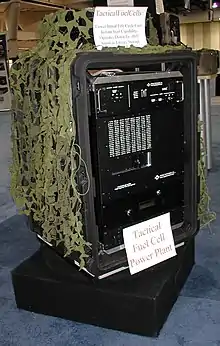Metal hydride fuel cell
Metal hydride fuel cells are a subclass of alkaline fuel cells that have been under research and development,[1][2][3][4][5] as well as scaled up successfully in operating systems.[6][7] A notable feature is their ability to chemically bond and store hydrogen within the fuel cell itself.

Characteristics
Metal hydride fuel cells have demonstrated the following characteristics:[8][9][10]
- The ability to be recharged with electrical energy (similar to NiMH batteries)
- Operating at low temperatures (down to −20 °C)
- Fast "cold start" properties
- Ability to operate for limited periods of time with no external hydrogen fuel source, enabling "hot swapping" of fuel canisters
Performance
Electrode active areas of metal hydride fuel cells have been scaled up from 60 cm2 to 250 cm2, enabling systems to be scaled up to 500 Watts.[11] The scaling up of electrode active areas also provided capabilities to develop higher power fuel cell stacks, each with 1500 Watts of power.[6] Metal hydride fuel cells have achieved a current density of 250 mA/cm2.[12] To test durability, fuel cell stacks were successfully operated for more than 7000 hours.[12]
Operating systems and applications

During the earlier phases of product development, there was a focus on single fuel cells and fuel cell stacks composed of multiple cells. The target applications included critical backup power for military and commercial applications.[13] The next phase was to design and build complete fuel cell systems that could be taken outside of the laboratory. Initial 50 Watt laboratory-based demonstration systems were integrated into 50 Watt portable systems with more robust packaging and interfacing.[12] Additional developments in both the fuel cell stack and system integration enabled a 1.0 kW system, complete with an inverter and onboard hydrogen storage using metal hydride storage canisters, to be operated and demonstrated in public.[6][14] Further developments in metal hydride fuel cell systems were pursued for the field power needs of soldiers, resulting in a prototype system meeting deployment requirements.[15] In tandem with product development, there was also a focus on developing capabilities for manufacturing and testing.[16] Metal hydride fuel cell systems have been integrated into microgrid systems at military bases for testing and evaluation.[17] Despite challenges,[18] the military maintains an active interest in fuel cells for a broad range of applications, including unmanned aerial vehicles, autonomous underwater vehicle, light-duty trucks, buses, and wearable technology systems.[19][20][21][22] Development of metal hydride fuel cell systems is continuing for military applications, with onboard hydrogen generation and fuel cells up to 5.0 kW.[23][24]
References
- Chartouni, D.; Kuriyama, N.; Kiyobayashi, T.; Chen, J. (2002-09-01). "Metal hydride fuel cell with intrinsic capacity". International Journal of Hydrogen Energy. 27 (9): 945–952. doi:10.1016/S0360-3199(01)00186-0. ISSN 0360-3199.
- Wang, Chunsheng; Appleby, A. John; Cocke, David L. (2004). "Alkaline Fuel Cell with Intrinsic Energy Storage". Journal of the Electrochemical Society. 151 (2): A260. Bibcode:2004JElS..151A.260W. doi:10.1149/1.1640627.
- Wang, X.H.; Chen, Y.; Pan, H.G.; Xu, R.G.; Li, S.Q.; L.X., Chen; Chen, C.P.; Wang, Q.D. (20 December 1999). "Electrochemical properties of Ml(NiCoMnCu)5 used as an alkaline fuel cell anode". Journal of Alloys and Compounds. 293–295: 833–837. doi:10.1016/S0925-8388(99)00367-9.
- Tanaka, H.; Kaneki, N.; Hara, H.; Shimada, K.; Takeuchi, T. (April 1986). "La—Ni system porous anode in an alkaline fuel cell". The Canadian Journal of Chemical Engineering. 64 (2): 267–271. doi:10.1002/cjce.5450640216.
- Lee, S.; Kim, J.; Lee, H.; Lee, P.; Lee, J. (29 March 2002). "The Characterization of an Alkaline Fuel Cell That Uses Hydrogen Storage Alloys". Journal of the Electrochemical Society. 149 (5): A603. Bibcode:2002JElS..149A.603L. doi:10.1149/1.1467365.
- Fok, Kevin; English, Nathan; Privette, Robert; Wang, Hong; Wong, Diana; Lowe, Timothy; Madden, Paul (October 2008). "Powering Up Metal Hydride Fuel Cells for Military Applications". Fuel Cell Seminar & Exposition 2008. Retrieved 22 March 2020.
- Lototskyy, Mykhaylo; Tolj, Ivan; Pickering, Lydia; Sita, Cordellia; Barbir, Frano; Yartys, Volodymyr (February 2017). "The use of metal hydrides in fuel cell applications". Progress in Natural Science: Materials International. 27 (1): 3–20. doi:10.1016/j.pnsc.2017.01.008.
- Ovshinsky, Stanford; Fok, Kevin; Venkatesan, Srinivasan; Corrigan, Dennis (May 2–4, 2005). "Metal Hydride Fuel Cells For UPS And Emergency Power Applications". BATTCON 2005 International Battery Conference and Trade Show.
- Schwartz, Brian; Fritzsche, Hellmut (28 February 2009). The Science and Technology of an American Genius: Stanford R Ovshinsky. World Scientific Pub Co Inc. ISBN 978-9812818393.
- Encyclopedia of electrochemical power sources. Garche, Jürgen., Dyer, Chris K. Amsterdam: Academic Press. 2009. ISBN 9780444527455. OCLC 656362152.CS1 maint: others (link)
- Fok, Kevin (4 December 2006). "Metal Hydride Fuel Cells, A New and Practical Approach for Backup and Emergency Power Applications". INTELEC 06 - Twenty-Eighth International Telecommunications Energy Conference: 1–6. doi:10.1109/INTLEC.2006.251656. ISBN 1-4244-0430-4. S2CID 43062441.
- Fok, Kevin (May 2007). "Recent Advances in Metal Hydride Fuel Cell Technology for UPS/Emergency Power Applications". Battcon Stationary Battery Conference. Retrieved 22 March 2020.
- Materials for fuel cells. Gasik, Michael, 1962-, Institute of Materials, Minerals, and Mining. Boca Raton: CRC Press. 2008. ISBN 978-1-84569-483-8. OCLC 424570885.CS1 maint: others (link)
- Godula-Jopek, Agata; Jehle, Walter; Wellnitz, Jorg (November 2012). Hydrogen Storage Technologies: New Materials, Transport and Infrastructure. Wiley‐VCH Verlag GmbH & Co. KGaA. doi:10.1002/9783527649921. ISBN 9783527649921.
- Lowe, T. D. (2008). "Mobile Fuel Cell Configurations for the U.S. Military". Ohio Fuel Cell Symposium 2008.
- Energy Technologies, Inc. (December 17, 2009). "Energy Technologies Awarded Third Ohio Third Frontier Fuel Cell Grant for Advanced Research, Development & Commercialization". Energy Technologies, Inc. Retrieved 2020-06-14.
- Madden, P. D. (March 23, 2016). "Modular, Scalable, Micro Grid Incorporating Traditional and Renewable Energy Systems". Microgrid Global Summit 2016.
- "Fuel Cells Fail to Make Inroads With the Military". www.nationaldefensemagazine.org. Retrieved 2020-03-24.
- "4 Ways Fuel Cells Power Up the U.S. Military". Energy.gov. Retrieved 2020-03-24.
- "Chevrolet Silverado ZH2 is a Fuel Cell-Powered Heavy-Duty Military Truck". Automobile. 2018-11-07. Retrieved 2020-03-25.
- Judson, Jen (2017-08-08). "Hydrogen fuel cell technology could bring stealth to Army vehicles". Defense News. Retrieved 2020-03-25.
- "Air Force demonstrating hydrogen as alternate fuel source". U.S. Air Force. Retrieved 2020-03-25.
- "Energy Technologies Inc. - Onsite Hydrogen". www.onsitehydrogen.com. Retrieved 2020-06-03.
- "Ultimate Fuel Cells". Ultimate Fuel Cells. Energy Technologies Inc. Retrieved 22 March 2020.